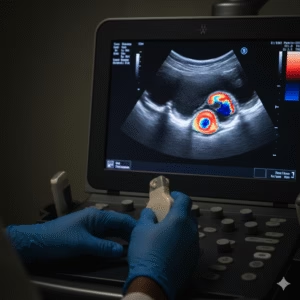Decoding Abnormal Uterine Bleeding (AUB): When is Irregular Bleeding a Sign of Something Serious?
For many women, the notion that menstrual cycles must be heavy or painful is an accepted, yet often debilitating, reality. Abnormal Uterine Bleeding (AUB)—defined as bleeding that is irregular, unusually heavy, or prolonged—is one of the most common reasons women seek medical attention. While often dismissed as “just a heavy period,” AUB is a significant health concern that can lead to severe anaemia, chronic pain, and signal underlying serious conditions. Taking proactive steps and consulting a highly regarded specialist in women’s health, such as Dr. Renu Yadav, ensures accurate diagnosis and effective treatment to restore health and quality of life. Women seeking expert care for this condition often look for a specialist who understands their needs, and many find that the best gynecologist in Gurgaon is crucial for managing these complex issues.
Understanding the Spectrum of Abnormal Uterine Bleeding (AUB)
Abnormal Uterine Bleeding (AUB) is a description of a symptom, not an illness itself. It refers to any bleeding from the uterus that deviates significantly from the characteristics of a normal menstrual cycle. Recognizing the signs of AUB is the first, vital step toward seeking professional evaluation.

What Constitutes a “Normal” Cycle?
A healthy menstrual cycle operates within well-defined, predictable boundaries. When providing your history to a gynecologist in Gurugram, these parameters are key:
- Frequency: Cycles that occur every 24 to 38 days.
- Duration: Bleeding that lasts 8 days or less.
- Regularity: Minimal variation (less than 9 days) from the shortest cycle length to the longest.
- Volume: Flow that is manageable, typically defined as less than 80 ml total loss per cycle, and does not require soaking through multiple hygiene products within an hour.
Key Types of Abnormal Uterine Bleeding
Any significant deviation from your established normal cycle should be evaluated by a healthcare provider. The terms below describe the various ways AUB presents:
- Heavy Menstrual Bleeding (HMB) or Menorrhagia: Excessive flow requiring frequent changes of pads/tampons, or the passage of large blood clots. This is a common form of irregular bleeding treatment is sought for.
- Intermenstrual Bleeding (Spotting): Bleeding that occurs between normal periods.
- Oligomenorrhea: Infrequent periods, typically occurring less than every 38 days.
- Polymenorrhea: Abnormally frequent periods, occurring more often than every 24 days.
- Postmenopausal Bleeding: Any bleeding that occurs a year or more after the last menstrual period is always considered abnormal and requires urgent medical investigation.
Featured Snippet Definition: Abnormal Uterine Bleeding (AUB) is defined by deviations in menstrual cycle frequency, duration, or flow volume. It is a common symptom stemming from hormonal imbalances, structural issues like uterine fibroids, or other systemic conditions, and requires specialized diagnosis.
The PALM-COEIN Classification: Systematic Causes of AUB
Specialists use the PALM-COEIN system to categorize the diverse origins of AUB into structural (PALM) and non-structural (COEIN) causes. This systematic approach allows for a precise diagnostic and treatment roadmap, ensuring that the patient receives targeted care.

PALM: Structural Causes (Often Visually Diagnosed)
These causes are often visible on imaging like ultrasound or during a direct uterine examination.
- Polyp (P): Benign growths (polyps) in the lining of the uterus (endometrium) or cervix. They commonly cause intermittent or heavy menstrual bleeding.
- Adenomyosis (A): The growth of the uterine lining tissue into the muscular wall of the uterus. This condition often results in heavy, painful periods and an enlarged, tender uterus, and is a key area in adenomyosis symptoms research.
- Leiomyoma (L) / Uterine Fibroids: Non-cancerous muscular tumors. Submucosal uterine fibroids—those protruding into the uterine cavity—are a frequent cause of HMB and pressure.
- Malignancy and Hyperplasia (M): Cancerous or pre-cancerous changes in the endometrium or cervix. While infrequent, this serious possibility mandates immediate investigation of persistent, unexplained AUB.
COEIN: Non-Structural Causes (Often Diagnosed by Testing)
These issues are generally systemic, hormonal, or related to medication.
- Coagulopathy (C): Bleeding disorders that impair the blood’s ability to clot normally.
- Ovulatory Dysfunction (O): The most frequent non-structural cause of AUB. It results from erratic or absent ovulation, leading to unstable hormonal levels. This is commonly seen in conditions like PCOS irregular periods, severe stress, or extreme weight fluctuations.
- Endometrial (E): Bleeding due to local issues within the uterine lining that do not fit into the PALM categories.
- Iatrogenic (I): Bleeding caused by medical treatment, often related to hormonal IUDs, contraceptive pills, or certain anticoagulant medications.
- Not yet Classified (N): Rare or highly specific causes that fall outside the other designations.
Impact and Risks of Untreated Heavy Menstrual Bleeding (HMB)
It is critical to understand that enduring AUB without treatment carries serious health risks that extend beyond simple discomfort.
Health Complications and Quality of Life
- Iron Deficiency Anaemia: Chronic, heavy blood loss is the leading cause of iron deficiency anaemia in women in many regions. Symptoms like profound fatigue, dizziness, and cognitive fog significantly impact a woman’s ability to work and engage in daily life.
- Chronic Pain and Discomfort: Conditions causing AUB, such as adenomyosis or large fibroids, can lead to chronic pelvic pain requiring long-term management.
- Fertility and Pregnancy Concerns: Irregular cycles due to hormonal imbalance bleeding (O-type AUB) often complicate conception, and structural causes (L-type AUB) can affect the ability to sustain a pregnancy.
- Psychological Toll: The unpredictability and inconvenience of heavy or irregular bleeding treatment may be required for can lead to anxiety, social isolation, and stress. (External Link: WebMD – Dealing with Heavy Periods)
The Diagnostic and Treatment Approach
A careful, evidence-based approach is used to move from symptom presentation to definitive treatment.
The Diagnostic Pathway
The initial consultation with an experienced professional, like a female gynae doctor Gurgaon trusts, involves both detailed history and diagnostic testing:
- Hormonal and Systemic Tests: Blood work, including a full blood count (for anaemia), thyroid function tests, prolactin levels, and coagulation studies, helps exclude systemic or hormonal conditions.
- Imaging: Transvaginal ultrasound (TVS) is the primary tool to visualize the uterus and ovaries, identifying structural issues like uterine fibroids or polyps.
- Endometrial Assessment: An endometrial biopsy (taking a sample of the uterine lining) or a Hysteroscopy is often performed, especially for women over 45, to rule out pre-cancerous conditions.
Targeted Treatment Strategies
Treatment is tailored to the specific PALM-COEIN cause and the patient’s priorities (e.g., preserving fertility).
- Medical Management:
- Hormonal Regulation: Oral contraceptives, progesterone, or the levonorgestrel-releasing IUD are highly effective for AUB caused by ovulatory dysfunction (PCOS, stress).
- Anti-Fibrinolytic Agents: Medications like tranexamic acid are used only during the period to significantly reduce blood flow volume (for HMB).
- Minimally Invasive Procedures (MIGS):
- Hysteroscopy and Resection: This is a preferred minimally invasive gynaecology technique, allowing direct visualization and removal of polyps or fibroids that are causing bleeding from inside the uterine cavity (Polypectomy or Myomectomy).
- Endometrial Ablation: A procedure to permanently destroy the uterine lining, offering a permanent, non-hormonal solution for HMB in women who have completed their families. (External Link: Mayo Clinic – Endometrial Ablation)
Conclusion

Irregular or heavy bleeding is not a consequence you must silently endure. Addressing Abnormal Uterine Bleeding (AUB) is a necessary step towards improving your daily energy, resolving pain, and safeguarding your long-term reproductive health.
Do not postpone a crucial health conversation. Take control of your well-being today and seek specialized evaluation. Schedule your confidential consultation with Dr. Renu Yadav, a leading female gynae doctor Gurgaon trusts for expert diagnosis and comprehensive irregular bleeding treatment. Contact us now to book your appointment and restore your cycle health.



